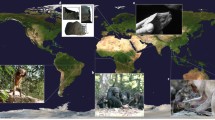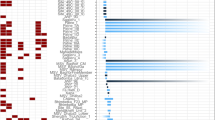Abstract
Which hominins are responsible for creating the Pleistocene archaeological record of Africa? Given that tool use has been recorded through paleontological and archaeological records over the last approximately 2.5 million years (Myr), we know that multiple hominin species must be involved in technological innovations at different times and locations. Although tool use and manufacture were once considered unique characteristics of our own genus (Homo), the last few decades have shown us that there may be archaeological evidence of tool use before the genus Homo (McPherron et al., 2010; Harmand et al., 2015). Another intractable issue is that it is nearly impossible to know whether archaeological materials and hominins are related to one another, even if found in situ at the same site. There are many lines of evidence that might mislead an association between hominin remains and archaeology: hominins can scavenge and repurpose tools, have late access to an already butchered carcass, or be preserved at a location where tools were either discarded by another hominin species or accumulated through other taphonomic processes. In short, identifying which hominins are responsible for the archaeological record is not always clear-cut. Here, we briefly discuss the 11 species of hominins currently recognized in Africa during the Pleistocene, selected by virtue of their temporal placement within the Pleistocene span (2.58 million years ago (Ma) to 11 thousand years ago (ka), the focal period of the volume) and their direct and indirect associations with tool-making capacity. For readership’s sake, we list the main traits (both derived and primitive) that distinguish the featured taxa in Table 1. Although all of these species may have been contributors to the archaeological record of Africa during the Pleistocene, only a handful seem to be unequivocally linked to tool use or manufacture.
Access this chapter
Tax calculation will be finalised at checkout
Purchases are for personal use only
Similar content being viewed by others
References
Antón, S. C. (2003). Natural history of Homo erectus. American Journal of Physical Anthropology, 122(S37), 126–170.
Asfaw, B., White, T., Lovejoy, O., Latimer, B., Simpson, S., & Suwa, G. (1999). Australopithecus garhi: A new species of early hominid from Ethiopia. Science, 284(5414), 629–635.
Asfaw, B., Gilbert, W. H., Beyene, Y., Hart, W. K., Renne, P. R., WoldeGabriel, G., et al. (2002). Remains of Homo erectus from Bouri, Middle Awash, Ethiopia. Nature, 416(6878), 317–320.
Berger, L. R., de Ruiter, D. J., Churchill, S. E., Schmid, P., Carlson, K. J., Dirks, P. H. G. M., et al. (2010). Australopithecus sediba: A new species of Homo-like australopith from South Africa. Science, 328(5975), 195–204.
Berger, L. R., Hawks, J., de Ruiter, D. J., Churchill, S. E., Schmid, P., Delezene, L. K., et al. (2015). Homo naledi, a new species of the genus Homo from the Dinaledi Chamber, South Africa. [JOUR]. eLife, 4, e09560.
Broom, R. (1938). The Pleistocene anthropoid apes of South Africa. Nature, 142, 377–379.
Bunn, H. T. (1981). Archaeological evidence for meat-eating by Plio-Pleistocene hominids from Koobi Fora and Olduvai Gorge. Nature, 291(5816), 574–577.
Conard, N. J., Serangeli, J., Bigga, G., & Rots, V. (2020). A 300,000-year-old throwing stick from Schöningen, northern Germany, documents the evolution of human hunting. Nature Ecology & Evolution, 4(5), 690–693.
Day, M. H. (1969). Omo human skeletal remains. Nature, 222(5199), 1135.
de Heinzelin, J., Clark, J. D., White, T., Hart, W., Renne, P., WoldeGabriel, G., et al. (1999). Environment and behavior of 2.5-million-year-old Bouri hominids. Science, 284(5414), 625–629.
Dirks, P. H. G. M., Roberts, E. M., Hilbert-Wolf, H., Kramers, J. D., Hawks, J., Dosseto, A., et al. (2017). The age of Homo naledi and associated sediments in the Rising Star Cave, South Africa. eLife, 6, e24231.
Dusseldorp, G., Lombard, M., & Wurz, S. (2013). Pleistocene Homo and the updated Stone Age sequence of South Africa. South African Journal of Science, 109(5/6).
Grine, F. E., Mongle, C. S., Fleagle, J. G., Hammond, A. S. (2022). The taxonomic attribution of African hominin postcrania from the Miocene through the Pleistocene: Associations and assumptions. Journal of Human Evolution, 173, p.103255.
Hammond, A. S., Royer, D. F., & Fleagle, J. G. (2017). The Omo-Kibish I pelvis. Journal of Human Evolution, 108, 199–219.
Hammond, A., Mavuso, S., Biernat, M., Braun, D., Jinnah, Z., Kuo, S., et al. (2021). New hominin remains and revised context from the earliest Homo erectus locality in East Turkana, Kenya. Nature Communications, 12(1), 1939.
Harmand, S., Lewis, J. E., Feibel, C. S., Lepre, C. J., Prat, S., Lenoble, A., et al. (2015). 3.3-million-year-old stone tools from Lomekwi 3, West Turkana, Kenya. Nature, 521(7552), 310–315.
Herries, A. I. R., Martin, J. M., Leece, A. B., Adams, J. W., Boschian, G., Joannes-Boyau, R., et al. (2020). Contemporaneity of Australopithecus, Paranthropus, and early Homo erectus in South Africa. Science, 368(6486), eaaw7293.
Hill, A. (1983). Hippopotamus butchery by Homo erectus at Olduvai. Journal of Archaeological Science, 10(2), 135–137.
Hlubik, S., Berna, F., Feibel, C., Braun, D., & Harris, J. W. K. (2017). Researching the nature of fire at 1.5 Mya on the site of FxJj20 AB, Koobi Fora, Kenya, using high-resolution spatial analysis and FTIR spectrometry. Current Anthropology, 58(S16), S243–S257.
Holloway, R. L., Broadfield, D., & Yuan, M. (2004). The human fossil record (Brain endocasts: The paleoneurological evidence) (Vol. 3). Wiley-Liss.
Hublin, J.-J., Ben-Ncer, A., Bailey, S. E., Freidline, S. E., Neubauer, S., Skinner, M. M., et al. (2017). New fossils from Jebel Irhoud, Morocco and the pan-African origin of Homo sapiens. Nature, 546(7657), 289.
Johanson, D. C., Taieb, M., & Coppens, Y. (1982). Pliocene hominids from the Hadar formation, Ethiopia (1973–1977): Stratigraphic, chronologic, and paleoenvironmental contexts, with notes on hominid morphology and systematics. American Journal of Physical Anthropology, 57, 373–402.
Kimbel, W. H., & Delezene, L. K. (2009). “Lucy” redux: A review of research on Australopithecus afarensis. Yearbook of Physical Anthropology, 52, 2–48.
Kivell, T. L., Kibii, J. M., Churchill, S. E., Schmid, P., & Berger, L. R. (2011). Australopithecus sediba hand demonstrates mosaic evolution of locomotor and manipulative abilities. Science, 333(6048), 1411–1417.
Kivell, T. L., Deane, A. S., Tocheri, M. W., Orr, C. M., Schmid, P., Hawks, J., et al. (2015). The hand of Homo naledi. Nature Communications, 6(1), 1–9.
Leakey, R. E. F. (1969). Early Homo sapiens remains from the Omo River region of south-west Ethiopia: Faunal remains from the Omo Valley. Nature, 222, 1132–1133.
Leakey, L. B., Tobias, P. V., & Napier, J. R. (1964). A new species of the genus Homo from the Olduvai Gorge. Nature, 202, 7–9.
Lordkipanidze, D., Ponce de León, M. S., Margvelashvili, A., Rak, Y., Rightmire, G. P., Vekua, A., et al. (2013). A complete skull from Dmanisi, Georgia, and the evolutionary biology of early Homo. Science, 342(6156), 326–331.
McPherron, S. P., Alemseged, Z., Marean, C. W., Wynn, J. G., Reed, D., Geraads, D., et al. (2010). Evidence for stone-tool-assisted consumption of animal tissues before 3.39 million years ago at Dikika, Ethiopia. Nature, 466(7308), 857–860.
Mongle, C. S., Strait, D. S., & Grine, F. E. (2019). Expanded character sampling underscores phylogenetic stability of Ardipithecus ramidus as a basal hominin. Journal of Human Evolution, 131, 28–39.
Pante, M. C. (2013). The larger mammal fossil assemblage from JK2, Bed III, Olduvai Gorge, Tanzania: Implications for the feeding behavior of Homo erectus. Journal of Human Evolution, 64(1), 68–82.
Patterson, D. B., Braun, D. R., Allen, K., Barr, W. A., Behrensmeyer, A. K., Biernat, M., et al. (2019). Comparative isotopic evidence from East Turkana supports a dietary shift within the genus Homo. Nature Ecology & Evolution, 3(7), 1048–1056.
Pearson, O. M., Royer, D. F., Grine, F. E., & Fleagle, J. G. (2008). A description of the Omo I postcranial skeleton, including newly discovered fossils. Journal of Human Evolution, 55(3), 421–437.
Pickering, R., & Herries, A. I. R. (2020). A new multidisciplinary age of 2.61–2.07 Ma for the Sterkfontein member 4 australopiths. In B. Zipfel, B. G. Richmond, & C. V. Ward (Eds.), Hominin postcranial remains from Sterkfontein, South Africa, 1936–1995 (pp. 21–32). Oxford University Press.
Pobiner, B. L., Rogers, M. J., Monahan, C. M., & Harris, J. W. K. (2008). New evidence for hominin carcass processing strategies at 1.5Ma, Koobi fora, Kenya. Journal of Human Evolution, 55(1), 103–130.
Potts, R., Behrensmeyer, A. K., Deino, A., Ditchfield, P., & Clark, J. (2004). Small mid-Pleistocene hominin associated with East African Acheulean technology. Science, 305(5680), 75.
Richter, D., Grün, R., Joannes-Boyau, R., Steele, T. E., Amani, F., Rué, M., et al. (2017). The age of the hominin fossils from Jebel Irhoud, Morocco, and the origins of the Middle Stone Age. Nature, 546(7657), 293–296.
Sano, K., Beyene, Y., Katoh, S., Koyabu, D., Endo, H., Sasaki, T., et al. (2020). A 1.4-million-year-old bone handaxe from Konso, Ethiopia, shows advanced tool technology in the early Acheulean. Proceedings of the National Academy of Sciences, USA, 117(31), 18393.
Scerri, E. M. L., Thomas, M. G., Manica, A., Gunz, P., Stock, J. T., Stringer, C., et al. (2018). Did our species evolve in subdivided populations across Africa, and why does it matter? Trends in Ecology & Evolution, 33(8), 582–594.
Semaw, S., Renne, P., Harris, J. W. K., Feibel, C. S., Bernor, R. L., Fesseha, N., et al. (1997). 2.5-million-year-old stone tools from Gona, Ethiopia. Nature, 385(6614), 333–336.
Semaw, S., Rogers, M. J., Simpson, S. W., Levin, N. E., Quade, J., Dunbar, N., et al. (2020). Co-occurrence of Acheulian and Oldowan artifacts with Homo erectus cranial fossils from Gona, Afar, Ethiopia. Science Advances, 6(10), eaaw4694.
Skinner, M. M., Stephens, N. B., Tsegai, Z. J., Foote, A. C., Nguyen, N. H., Gross, T., et al. (2015). Human-like hand use in Australopithecus africanus. Science, 347(6220), 395–399.
Spoor, F., Gunz, P., Neubauer, S., Stelzer, S., Scott, N., Kwekason, A., et al. (2015). Reconstructed Homo habilis type OH 7 suggests deep-rooted species diversity in early Homo. Nature, 519(7541), 83–86.
Susman, R. (1988). Hand of Paranthropus robustus from member 1, Swartkrans: Fossil evidence for tool behavior. Science, 240(4853), 781–784.
Vidal, C. M., Lane, C. S., Asrat, A., Barfod, D. N., Mark, D. F., Tomlinson, E. L., et al. (2022). Age of the oldest known Homo sapiens from eastern Africa. Nature, 601(7894), 579–583.
Villmoare, B., Kimbel, W. H., Seyoum, C., Campisano, C. J., DiMaggio, E. N., Rowan, J., et al. (2015). Early Homo at 2.8 Ma from Ledi-Geraru, Afar, Ethiopia. Science, 347(6228), 1352–1355.
Walker, A., Leakey, R. E., Harris, J. M., & Brown, F. H. (1986). 2.5-myr Australopithecus boisei from west of Lake Turkana, Kenya. Nature, 322, 517.
Wilkins, J., Schoville, B. J., Brown, K. S., & Chazan, M. (2012). Evidence for early hafted hunting technology. Science, 338(6109), 942–946.
Wood, B. (1992). Origin and evolution of the genus homo. Nature, 355(6363), 783–790.
Wood, B., & Boyle, E. K. (2016). Hominin taxic diversity: Fact or fantasy? American Journal of Physical Anthropology, 159(S61), 37–78.
Wood, B. A., & Constantino, P. (2007). Paranthropus boisei: Fifty years of evidence and analysis. American Journal of Physical Anthropology, Suppl 45, 106–132.
Acknowledgments
CSM was supported by the Gerstner Fellowship and the Gerstner Family Foundation, the Kalbfleisch Fellowship, and the Richard Gilder Graduate School of the American Museum of Natural History.
Author information
Authors and Affiliations
Corresponding author
Editor information
Editors and Affiliations
Rights and permissions
Copyright information
© 2023 The Author(s), under exclusive license to Springer Nature Switzerland AG
About this chapter
Cite this chapter
Hammond, A.S., Mongle, C. (2023). Pleistocene Hominin Fossil Record of Africa. In: Beyin, A., Wright, D.K., Wilkins, J., Olszewski, D.I. (eds) Handbook of Pleistocene Archaeology of Africa . Springer, Cham. https://doi.org/10.1007/978-3-031-20290-2_119
Download citation
DOI: https://doi.org/10.1007/978-3-031-20290-2_119
Published:
Publisher Name: Springer, Cham
Print ISBN: 978-3-031-20289-6
Online ISBN: 978-3-031-20290-2
eBook Packages: HistoryHistory (R0)




